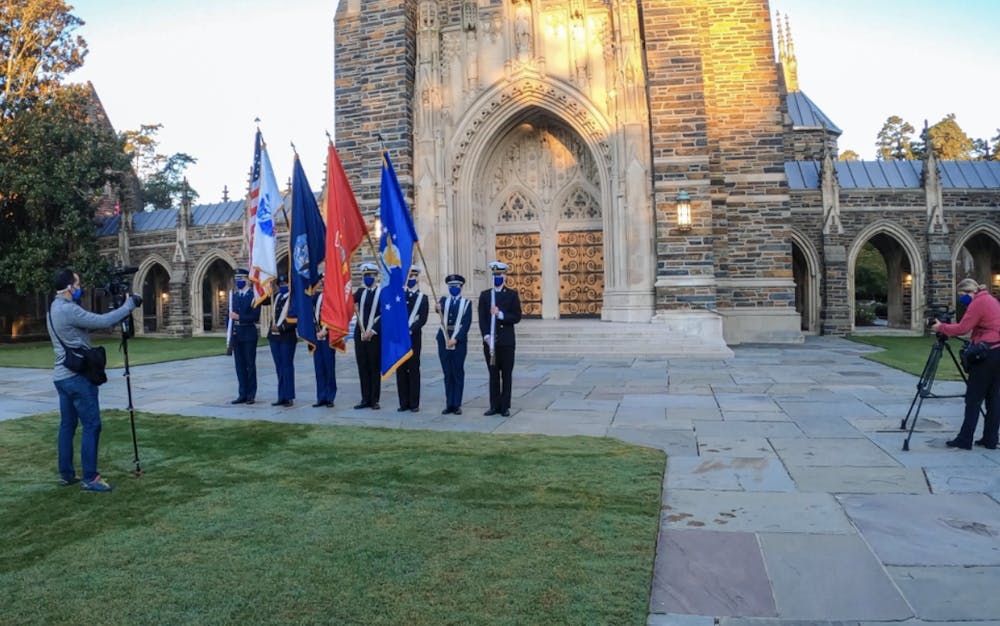Ever wonder how Duke’s websites and social media pages always feature exquisite images of campus? Those photos are produced by a little-known team that works in a building on Chapel Drive seldom visited by students.
Led by Blyth Morrell, assistant vice president for digital and brand strategy, the Digital and Brand Strategy team is made up of multimedia producers and designers who capture events, classroom learning and scenes of student life on campus. They’re also responsible for institutional web initiatives; digital asset management; and overall brand strategy, design, standards and style guides.
If you’ve ever seen an epic image of Duke from above, you’re likely familiar with the work of Bill Snead, digital asset manager and university drone pilot. He trained as a photographer at Rochester Institute of Technology and joined Duke as a Human Resources employee before joining University Communications.
As a teenager, Snead was fascinated by both aviation and photography. As photo drone technology became more mainstream, he was able to fuse his twin passions to produce a new type of media for Duke. He said he wants to take photos of the University with drones so that not all images come from his height of 5 foot 10. He finds that getting 20 to 30 feet off the ground allows him and viewers to “explore the campus all over again.”
Working on the DBS team means flexibility and innovation. Senior Multimedia Producer Megan Mendenhall, who has worked at Duke for over 15 years, said that she doesn’t have a typical workday because she and the team are always working on new projects.
"I love the variety,” she said. “One of my favorite aspects of my work is getting to meet new people from across the University."
Another senior multimedia producer, Jared Lazarus, who joined Duke after a career in the newspaper industry, said his team actively seeks out events, campus scenes and projects to cover. They also partner with departments and groups within the University who would like to have their initiatives documented.
Lazarus and his teammates also help train students interested in photography, including students from the Duke Students Instagram team, The Chronicle, the Duke Photography Club and North Carolina Central University.
While most of the DBS team consists of multimedia producers, Sam Huntley and Caroline Pate are information designers and web developers who design virtual experiences that share what occurred in different events. Huntley and Pate develop pages for single events, such as the Veteran’s Day ceremony and Presidential Awards, as well as longer-term initiatives such as the redesign of the Duke homepage.
The pandemic's impact on DBS
As with most aspects of the University, COVID-19 has changed how the DBS team works.
In one sense, the pandemic was a boon. Photographers and videographers aren’t allowed to fly imaging drones over people, so when fewer people were around at the beginning of the pandemic, there were more opportunities to capture images and video with drones.
Mendenhall said the beginning of the pandemic brought with it a need to capture new types of images for content producers at the University to use, such as students and administrators following the school’s temporary procedures. Getting these images, such as those of people wearing masks and being tested for the coronavirus, has necessitated that content creators come in multiple times a week since the onset of the virus.
According to Julie Schoonmaker, a video communications specialist, video has become a crucial way for Duke to share its updates about pandemic protocols. The team also created materials to inform students and faculty about those protocols, from articles about sanitation stations to the Duke United website where announcements have been posted.
Without any in-person events to photograph, the team focused on helping people improve their virtual events and chronicling those events. They also sent out images to community members to use as virtual backgrounds on Zoom and other video conferencing services.
The team’s central focus since the onset of the pandemic has been “all about finding new ways to be innovative within the parameters we are in right now,” Schoonmaker said.
All of the members of the team seem to get along well with each other.
“I genuinely enjoy my colleagues,” Mendenhall said. “We really do function as a team. If one of us shines, it’s because all of us worked in the background to make that happen.”
Or, as Snead put it, “We all seem to be able to read each other's minds.”
Get The Chronicle straight to your inbox
Signup for our weekly newsletter. Cancel at any time.

